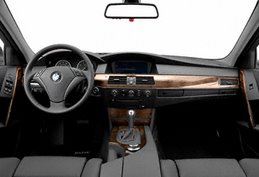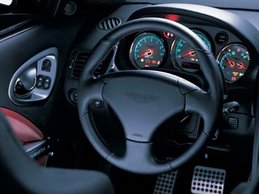 Audi A6 3.2 Quattro - The 3.1-liter V-6 (it’s also available in the smaller A4) is a heavily revised version of Audi’s earlier 3.0-liter and 2.8-liter all-aluminum 60-degree V-6 engines. To avoid confusion, we should mention that Audi calls it a 3.2-liter, but it is, at 3123 cubic centimeters, a 3.1-liter engine. It may seem as if the new six’s four valves per cylinder are a retrograde step versus the five-valve-per-cylinder arrangement of the 3.0-liter that preceded it, but the new engine gets Audi’s direct fuel-injection system (FSI) that allows a staggering 12.5:1 compression ratio; the previous six had a 10.0:1 compression ratio. With an additional 147 cubic centimeters of displacement and the extra squish in the combustion chamber, the direct-injection six puts out 255 horsepower at 6500 rpm (35 more horses than previously) and 243 pound-feet of torque at an easily accessible 3250 rpm.
Audi A6 3.2 Quattro - The 3.1-liter V-6 (it’s also available in the smaller A4) is a heavily revised version of Audi’s earlier 3.0-liter and 2.8-liter all-aluminum 60-degree V-6 engines. To avoid confusion, we should mention that Audi calls it a 3.2-liter, but it is, at 3123 cubic centimeters, a 3.1-liter engine. It may seem as if the new six’s four valves per cylinder are a retrograde step versus the five-valve-per-cylinder arrangement of the 3.0-liter that preceded it, but the new engine gets Audi’s direct fuel-injection system (FSI) that allows a staggering 12.5:1 compression ratio; the previous six had a 10.0:1 compression ratio. With an additional 147 cubic centimeters of displacement and the extra squish in the combustion chamber, the direct-injection six puts out 255 horsepower at 6500 rpm (35 more horses than previously) and 243 pound-feet of torque at an easily accessible 3250 rpm.The package’s 18-inch wheels look great, but the firm suspension and large wheels lead to a hard ride. We should have opted for the stand-alone 17-inch wheels, which we felt would have been a nice compromise between style and ride comfort. For 2006, A6s equipped with Quattro all-wheel drive get 17-inch wheels standard — base front-wheel-drive A6s soldier on with the 16-inchers. Other options on our tester included a navigation system ($1500), premium leather upholstery ($1000), rear parking sensors ($350), and a Premium package of sunroof, xenon headlights, Bose stereo, and wood interior trim ($3000).
Despite the diminutive wheels, the A6 ran up an impressive 4500 miles in its first month. Before we knew it, the car’s computer was demanding a service stop, at 5000 miles. During that visit, complaints about clicking noises coming from the engine were found to be part of the normal operation of the FSI. Stand outside an idling A6 3.2, and the engine ticks as the high-pressure injectors spray into the cylinders. We’ve noticed that Volkswagen and Audi’s other FSI engine, the 2.
 0-liter turbo four in the A3 and GTI, makes a similar sound while idling.
0-liter turbo four in the A3 and GTI, makes a similar sound while idling.As a highway cruiser, our A6 was a favorite among staffers. Logbook entries paid tribute to the comfortable seats, supple ride, quiet and beautifully crafted cabin, and 21.1-gallon tank that allows nearly 500 miles before needing a refill. Over 40,000 miles, we averaged 23 mpg. It wasn’t long before the A6 required a 15,000-mile service. No problems were reported, and after an oil change and thorough inspection, we were sent on our way.
It might have been in its element on the highway, but the A6 proved to be less pleasing around town. In stop-and-go traffic, the big Audi is prone to lurch and surge. The problem has three causes. An overly sensitive brake pedal makes smooth stops a challenge. Then there is the sleepy throttle that snoozes through initial travel, awakens suddenly, and then gives more throttle than the driver wants. Finally, the transmission resists downshifting and then finally slams into a lower gear with the finesse of a fat guy climbing a fence. The situation improves with the transmission in sport mode — throttle response doesn’t get any better, but the transmission tends to hold onto lower gears.
When winter arrived, we put on Pirelli Sotto Zero snow tires. Equipped with the Pirellis, Quattro all-wheel drive, and standard stability control, the A6 became a snow-season favorite. Winter trips included jaunts from Michigan to Florida, South Carolina, and Virginia. Spotting the A6 in the parking lot became a rare occurrence. At its one-year anniversary, the A6 had traveled more than 35,000 miles, and the service computer alerted us that the front brake pads needed to be replaced. New pads cost us nothing, as even wear items were covered by Audi’s comprehensive free maintenance. If our A6 had been a 2007 model, those would have cost about $400.
After 13 months and 40,000 miles of running our red car hard, many of us remarked at how well it held up — in fact, far better than our experience with a lo
 ng-term Acura RL (it required eight unscheduled stops) that was also in our fleet during much of the A6’s stay. We did have the A6’s steering wheel replaced — under warranty — after leather stitching started to unravel, and there were typical signs of wear, such as dirty carpets and a shiny patina on the leather seats.
ng-term Acura RL (it required eight unscheduled stops) that was also in our fleet during much of the A6’s stay. We did have the A6’s steering wheel replaced — under warranty — after leather stitching started to unravel, and there were typical signs of wear, such as dirty carpets and a shiny patina on the leather seats.We did, however, take the A6 to the dealer for five unscheduled stops. The faulty trunk latch and the key system each brought us in twice and the brakes once, and we also pulled in when the computer prematurely called for the 15,000-mile service at 11,000 miles. Except for the brakes, however, the other problems were not debilitating, and we could have waited until the scheduled service stops.













No comments:
Post a Comment